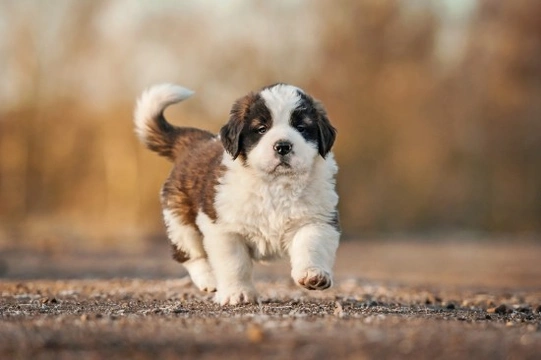
Saint Bernard dog hereditary health and health testing
The Saint Bernard dog is classed as a large or giant breed that originated in the Swiss Alps, and was widely used originally as a mountain rescue dog, which brought the breed to prominence as a lifesaver and famous search and rescue recovery dog. They have a very large, heavy and muscular appearance, and can stand up to 35.5” tall at the withers and weigh up to 120kg, with males tending to be slightly larger than females.
The coat of the Saint Bernard can be either rough or smooth, and is generally red or mahogany in colour, with white areas around the neck and legs and sometimes, black on the face. Despite their large size, they are generally gentle, calm dogs that are quiet within the home, trustworthy with children, and friendly with both strangers and family members.
While the breed is still used within the Swiss Alps for rescue work and other duties, they are much more widely kept as pets, both within the UK and further afield. If you love large and giant breeds, the Saint Bernard might be one worth considering. It is of course important to do plenty of research into any dog breed before committing to a purchase or adoption, and for giant breeds, it is particularly important to find out about the health and average longevity of the breed in detail. We will look into these aspects of ownership in more detail within this article.
Saint Bernard longevity
The average lifespan of the Saint Bernard is 7-10 years, which provides quite a wide range of variance, and does not reflect a particularly long lifespan. However, large and particularly giant breeds tend to live shorter lifespans than their smaller counterparts, and as such, the average lifespan for the breed is within the normal range for all breeds of a similar size and build.
Saint Bernard genetic diversity
The coefficient of inbreeding statistic for the Saint Bernard breed is 5%, which falls well within the accepted norm for pedigree dog breeds of 6.25% or lower. This indicates that the Saint Bernard breed as a whole is not subjected to a large amount of inbreeding in order to keep breed lines viable.
Conformation issues
The sheer size and weight of the Saint Bernard breed means that a significant amount of strain is placed on the joints and muscles, as well as on the heart itself. Care should be taken, particularly with young dogs of the breed that are still growing, to ensure that they are not strained or placed under undue pressure.
The Saint Bernard is also a serious drooler, and can often be seen with “shoelaces” of slobber hanging from their mouths! As a very large, deep chested breed, the Saint Bernard is also at risk of developing bloat or gastric torsion, a very serious condition in which the stomach fills with a dangerous amount of gas, and may flip over on itself.
Health testing for the Saint Bernard
The British Veterinary Association and The Kennel Club recommend the following health tests and screening schemes for the Saint Bernard dog:
- Hip score testing, with the mean score across the breed being 22.8. This is a very high figure, and potential breeding stock should receive a hip score below this figure to be considered viable.
- Elbow score testing, with the ideal score being zero.
The Saint Bernard breed is one of fifteen breeds that the UK Kennel Club classes as “high profile,” meaning that the breed is classed as of concern due to the prevalence of a range of hereditary health problems that can have a significant impact on the quality of life and longevity of the breed as a whole.
Other health issues
As well as the conditions noted above, the Saint Bernard is also known to be potentially prone to a range of other health issues, for which no pre-breeding health screening is currently available. Such conditions include:
- Entropion or ectropion of the eyelids.
- Lip fold pyoderma.
- Callus dermatitis, a condition of the skin of the knees and elbow joints.
- Panosteitis, an inflammatory condition of the bones.
- Primary hypothyroidism, an underactivity of the thyroid gland in affected dogs.
- Cataracts of the eyes, although these are usually operable in order to preserve vision.
- Pyometra in female dogs, a serious infection of the womb.
- Various types of ocular defects.
- Haemophilia, a blood clotting disorder.
- Various types of heart disease, including dilated cardiomyopathy, which can lead to heart failure.
- Cruciate ligament problems of the hind limbs.
- Various different types of cancers, including neoplasia and osteosarcoma (cancer of the bone).
- Idiopathic epilepsy.
- Osteochondrosis of the shoulder, which can lead to chronic pain and muscle stiffness.
- An autoimmune disorder called uveodermatological syndrome, causing the progressive destruction of the body’s tissues, which leads to blindness and is ultimately fatal.



